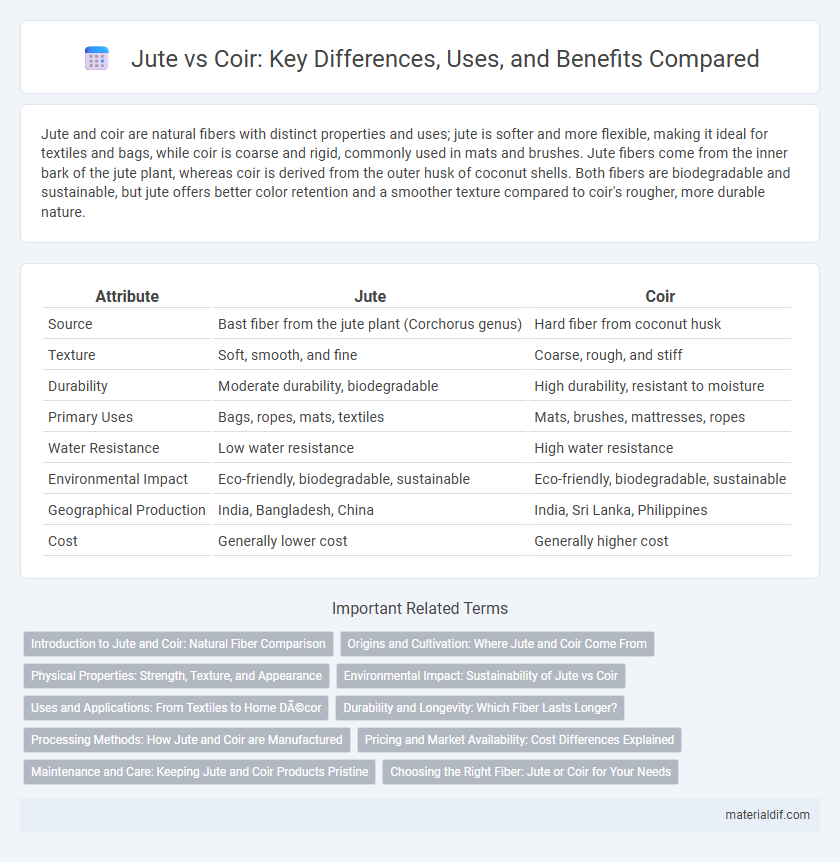Jute and coir are natural fibers with distinct properties and uses; jute is softer and more flexible, making it ideal for textiles and bags, while coir is coarse and rigid, commonly used in mats and brushes. Jute fibers come from the inner bark of the jute plant, whereas coir is derived from the outer husk of coconut shells. Both fibers are biodegradable and sustainable, but jute offers better color retention and a smoother texture compared to coir's rougher, more durable nature.
Table of Comparison
| Attribute | Jute | Coir |
|---|---|---|
| Source | Bast fiber from the jute plant (Corchorus genus) | Hard fiber from coconut husk |
| Texture | Soft, smooth, and fine | Coarse, rough, and stiff |
| Durability | Moderate durability, biodegradable | High durability, resistant to moisture |
| Primary Uses | Bags, ropes, mats, textiles | Mats, brushes, mattresses, ropes |
| Water Resistance | Low water resistance | High water resistance |
| Environmental Impact | Eco-friendly, biodegradable, sustainable | Eco-friendly, biodegradable, sustainable |
| Geographical Production | India, Bangladesh, China | India, Sri Lanka, Philippines |
| Cost | Generally lower cost | Generally higher cost |
Introduction to Jute and Coir: Natural Fiber Comparison
Jute and coir are prominent natural fibers derived from the jute plant's stem and coconut husk, respectively, known for their eco-friendly properties and biodegradability. Jute fibers are softer, finer, and more durable, typically used in textiles, bags, and carpets, while coir fibers are coarser, stiffer, and water-resistant, favored for brushes, mats, and upholstery padding. Both fibers contribute significantly to sustainable industries, with jute dominating in textile applications and coir excelling in erosion control and household products.
Origins and Cultivation: Where Jute and Coir Come From
Jute primarily originates from the Indian subcontinent, particularly Bangladesh and India, where the warm and humid climate supports its cultivation. Coir comes mainly from the coastal regions of India, Sri Lanka, and the Philippines, harvested from the fibrous husk surrounding coconut shells. Both fibers thrive in tropical environments but differ significantly in source plants and geographical cultivation zones.
Physical Properties: Strength, Texture, and Appearance
Jute fibers exhibit high tensile strength and a soft, smooth texture, making them suitable for fine textiles, while coir fibers are coarser, rougher, and less flexible but possess greater durability and resistance to wear. Jute has a natural golden color and a lustrous appearance, contrasting with coir's brownish hue and matte finish. The physical strength of coir surpasses jute in coarse applications, but jute's finer texture allows for more versatile fabric production.
Environmental Impact: Sustainability of Jute vs Coir
Jute and coir both offer eco-friendly alternatives to synthetic materials, but jute stands out for its lower water and pesticide requirements, enhancing its sustainability profile. Jute cultivation promotes soil health through natural nitrogen fixation, whereas coir, derived from coconut husks, relies on byproduct valorization, reducing agricultural waste. Both fibers are biodegradable, but jute's faster growth cycle and reduced chemical inputs contribute to a smaller overall environmental footprint compared to coir.
Uses and Applications: From Textiles to Home Décor
Jute fibers are extensively used in the production of textiles such as sacks, ropes, and gunny bags, valued for their softness and breathability, making them ideal for clothing and home decor items like curtains and upholstery. Coir, derived from coconut husks, is primarily employed in floor mats, brushes, mattresses, and erosion control products due to its rough texture and durability. Both materials offer sustainable, biodegradable solutions across diverse applications, with jute favored in fashion and interior decor, while coir excels in heavy-duty domestic and industrial uses.
Durability and Longevity: Which Fiber Lasts Longer?
Jute and coir fibers differ significantly in durability and longevity, with coir being more resistant to moisture and decay, making it ideal for outdoor and heavy-use applications. Jute, while softer and more flexible, tends to degrade faster when exposed to prolonged humidity and wear. Coir's natural resilience ensures it typically lasts longer than jute in demanding environments.
Processing Methods: How Jute and Coir are Manufactured
Jute fibers are extracted through a water retting process where the stalks are submerged to soften and separate the fibers, followed by washing, drying, and spinning into yarn. Coir production involves soaking coconut husks in water for several months to loosen the fibers, which are then extracted, cleaned, and spun into coarse yarn. The key difference lies in the retting duration and fiber extraction techniques, making jute fibers finer and more suitable for textiles, while coir is coarser and primarily used for mats and brushes.
Pricing and Market Availability: Cost Differences Explained
Jute typically offers a more affordable price point compared to coir due to lower production costs and widespread cultivation in countries like India and Bangladesh. Coir, derived from coconut husks, tends to be pricier because of its labor-intensive extraction process and limited growing regions primarily in South Asia. Market availability favors jute with higher global demand and well-established supply chains, whereas coir's availability fluctuates with seasonal coconut harvests and regional production capacity.
Maintenance and Care: Keeping Jute and Coir Products Pristine
Jute products require gentle cleaning with a vacuum or a soft brush to remove dust, avoiding excessive moisture to prevent mold growth. Coir, being more water-resistant, can tolerate occasional rinsing but should be thoroughly dried to maintain longevity and prevent fiber degradation. Both materials benefit from avoiding prolonged exposure to direct sunlight to preserve color vibrancy and structural integrity.
Choosing the Right Fiber: Jute or Coir for Your Needs
Jute offers a soft texture and high tensile strength, making it ideal for textiles, bags, and upholstery, while coir provides coarse fibers suited for mats, brushes, and erosion control due to its durability and water resistance. Consider environmental conditions, as jute thrives in humid climates but deteriorates quickly when exposed to moisture, whereas coir's resilience to water makes it preferable for outdoor use. Selecting the right fiber depends on balancing softness and flexibility with toughness and longevity for your specific application.
Jute vs Coir Infographic

 materialdif.com
materialdif.com